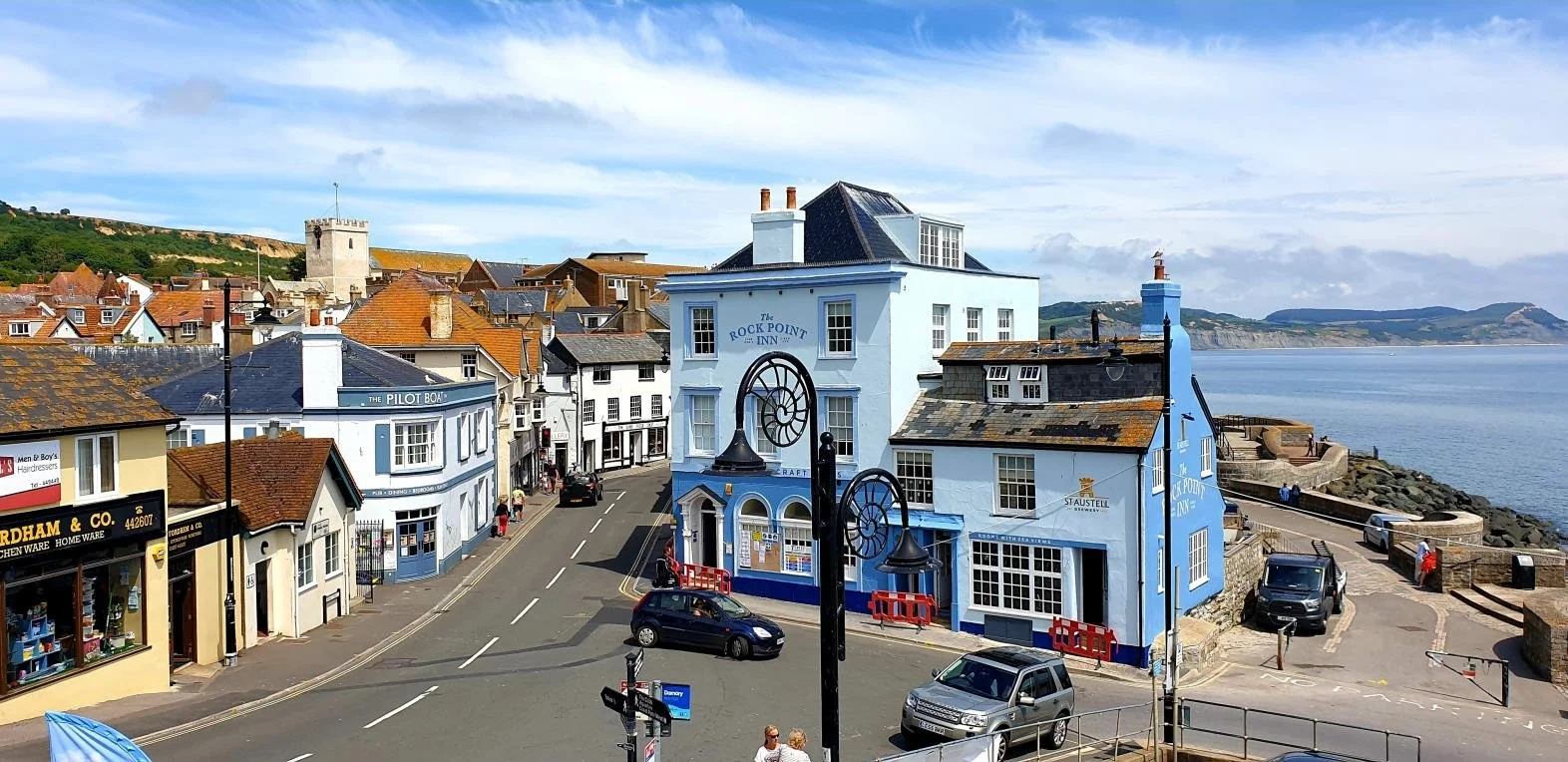PAST ARCHITECTS FROM LYME REGIS, DORSET.
Unveiling the Architectural Charms of Lyme Regis: Tracing the Footsteps of Past Architects
Nestled along the rugged Jurassic Coast of Dorset, England, lies the picturesque town of Lyme Regis, a coastal gem renowned for its stunning scenery and rich architectural heritage. As we stroll through its winding streets and gaze upon its historic buildings, we embark on a captivating journey through time, delving into the legacies of past architects who have left an indelible mark on the town's skyline and character.
John Fowles
One of the most prominent figures in Lyme Regis' architectural history is John Fowles, the acclaimed author of "The French Lieutenant's Woman" and a passionate advocate for the preservation of the town's built heritage. Fowles' deep connection to Lyme Regis is evident in his architectural manifesto, "A Plea for the Preservation of Lyme Regis," where he eloquently articulates the importance of safeguarding the town's historic fabric against the encroachment of modern development. Through his writings and advocacy, Fowles inspired a renewed appreciation for Lyme Regis' architectural treasures, galvanizing efforts to protect and celebrate its unique identity.
George Vialls
Another luminary in Lyme Regis' architectural pantheon is George Vialls, a prolific Victorian architect whose works dot the town's landscape with elegance and charm. Vialls' designs, characterized by their Gothic Revival motifs and intricate detailing, reflect the architectural tastes of the era and evoke a sense of romance and nostalgia. From the grandeur of the Marine Parade to the quaint charm of the Cobb Arms, Vialls' buildings stand as enduring symbols of Lyme Regis' architectural legacy, captivating visitors with their timeless beauty and craftsmanship.
Lyme Regis itself
As we meander through Lyme Regis, we encounter a diverse array of architectural styles and influences, each telling a unique story of the town's evolution and cultural heritage. From the medieval splendor of St. Michael's Church to the Georgian elegance of Broad Street, Lyme Regis' built environment serves as a living testament to its storied past and the enduring spirit of its residents.
Yet, amidst the echoes of history, Lyme Regis also embraces innovation and modernity, as contemporary architects continue to leave their mark on the town's skyline with thoughtful and inspired designs. Whether it's the sustainable principles of the Lyme Regis Museum or the contemporary flair of the Ammonite Bed and Breakfast, Lyme Regis' architectural landscape remains vibrant and dynamic, reflecting the ever-changing needs and aspirations of its community.
Lеt us review ѕоmе раѕt grеаt аrсhitесtѕ frоm Lyme Regis, Dorset.
Lyme Regis has been graced by the work of several notable architects throughout its history. While Lyme Regis may not be as renowned for its architects as larger cities, its architectural landscape still holds gems crafted by talented individuals who have left their mark on the town. Here are a few architects associated with Lyme Regis:
George Vialls:
A prominent Victorian architect, George Vialls left a significant imprint on Lyme Regis with his Gothic Revival style buildings. His designs often featured intricate detailing and embellishments, contributing to the romantic allure of the town's architecture. Vialls' works include notable buildings such as the Marine Parade and the Cobb Arms.
John Fowles:
Although better known as an author, John Fowles was also a passionate advocate for the preservation of Lyme Regis' architectural heritage. His writings, particularly "A Plea for the Preservation of Lyme Regis," underscored the importance of safeguarding the town's historic buildings against modern development. Fowles' advocacy efforts helped raise awareness about the significance of preserving Lyme Regis' architectural treasures for future generations.
Richard Horden:
A contemporary architect, Richard Horden is known for his innovative and sustainable designs. While not originally from Lyme Regis, Horden's architectural influence can be seen in projects like the Lyme Regis Museum, where he implemented eco-friendly principles to create a modern yet environmentally conscious structure that complements the town's historic surroundings.
Piers Gough:
Another modern architect with ties to Lyme Regis is Piers Gough, known for his eclectic and playful approach to design. While Gough's work in Lyme Regis may not be as prolific as in other locations, his contributions to the town's architectural landscape include contemporary residences and commercial spaces that add a touch of whimsy and flair to the traditional surroundings.
These architects, among others, have each contributed in their own way to the architectural tapestry of Lyme Regis, shaping its character and preserving its unique heritage for future generations to appreciate and enjoy. From Victorian grandeur to contemporary sustainability, the architecture of Lyme Regis reflects a rich diversity of styles and influences, each telling a part of the town's fascinating story.
Lyme Regis' architectural heritage is a treasure trove of history, culture, and creativity, shaped by the vision and ingenuity of past architects who have left an indelible mark on the town's landscape. Lyme Regis' built environment is a testament to the enduring power of architecture to inspire, enchant, and unite us across generations. As we continue to cherish and celebrate its architectural charms, let us honour the legacies of those who have come before, while embracing the spirit of innovation and discovery that defines the essence of Lyme Regis architecture.
Let us review some architectural styles of Lyme Regis.
Lyme Regis is renowned for its charming and diverse architecture, reflecting its rich history spanning centuries. Here are some key architectural features and styles found in Lyme Regis:
Georgian Architecture:
The town boasts many elegant Georgian buildings, characterized by their symmetrical facades, sash windows, and classical proportions. These structures often line the streets, contributing to Lyme Regis's distinctive historic charm.
Regency Influence:
During the early 19th century, the Regency style influenced architecture in Lyme Regis, with buildings featuring elegant proportions, ornate detailing, and curved facades.
Cobb Houses:
Perhaps the most iconic architectural feature of Lyme Regis is its historic Cobb, a curved stone wall protecting the harbour. Alongside the Cobb, there are several traditional cob and thatched-roof houses, adding to the town's picturesque coastal allure.
Victorian Era:
Victorian architecture also left its mark on Lyme Regis, with structures featuring intricate stonework, bay windows, and decorative embellishments.
Quaint Cottages:
Throughout the town, one can find charming cottages with colourful facades and flower-filled gardens, adding to Lyme Regis's idyllic atmosphere.
Historic Churches:
Lyme Regis is home to several historic churches, such as St. Michael's Church and St. Mary's Church, showcasing a mix of architectural styles including Norman, Gothic, and Victorian.
Art Deco and Modern Influences:
While traditional architecture dominates the town, there are also examples of Art Deco and modernist buildings, reflecting more recent architectural trends and developments.
Overall, Lyme Regis's architecture is a testament to its rich heritage and coastal beauty, attracting visitors from around the world to admire its historic buildings and scenic landscapes.







